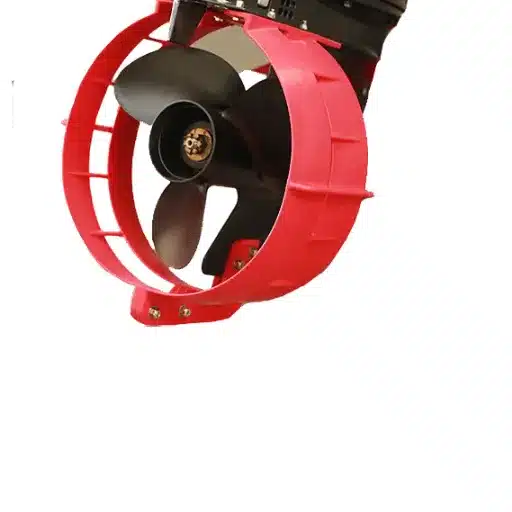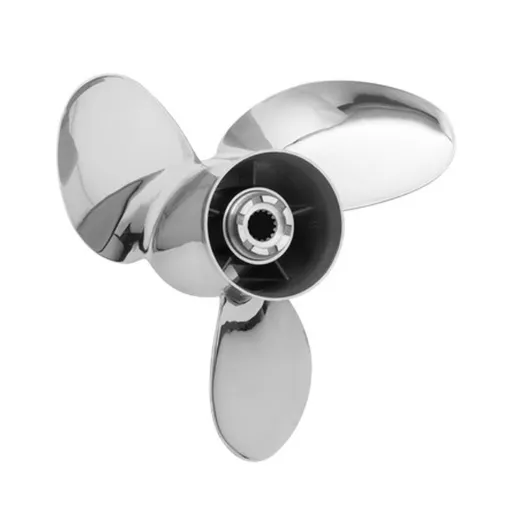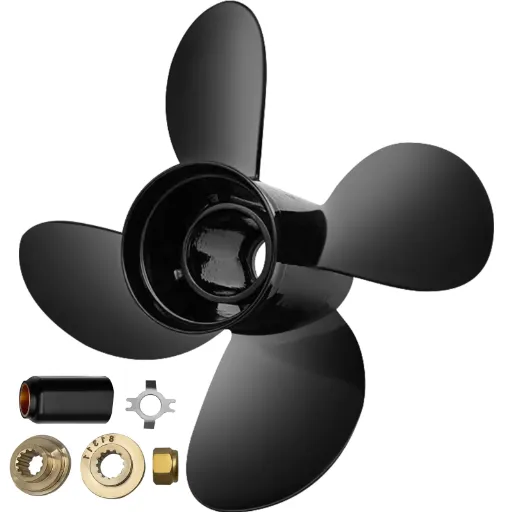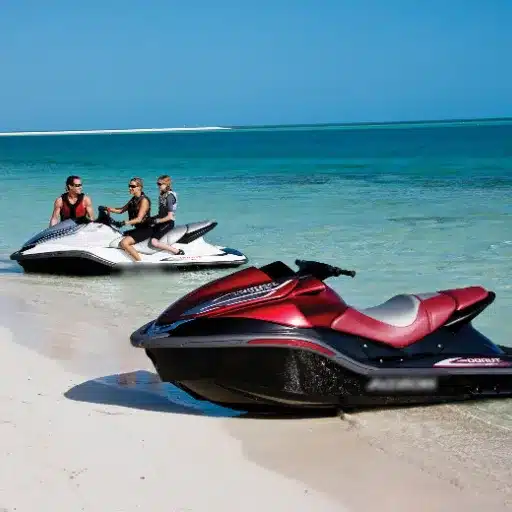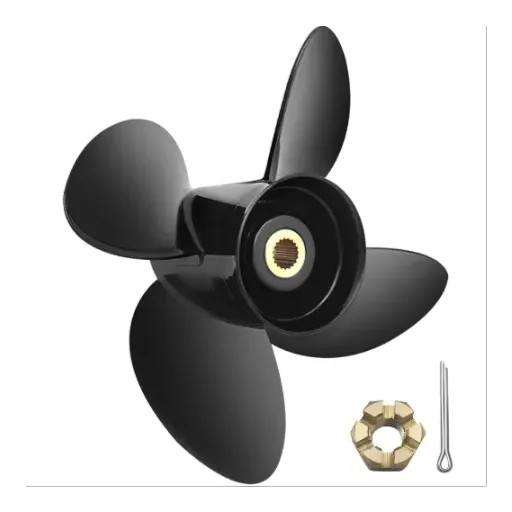When it comes to marine propulsion, the type of propeller you choose affects performance, the maneuverability of the vessel, and overall efficiency. Left-hand and right-hand propellers are commonly discussed options, each with different directions of rotation influencing the way in which they interact with the water. But what do these terms really mean for the operation of a vessel? This article delves into the fundamental differences between left-hand and right-hand propellers, including their mechanics and uses, while also covering the practical aspects that concern every boater and professional in the field. Whether you’re modifying your boat or just intent on learning more about marine engineering, this guide will help you choose wisely about your need for a particular propeller.
Introduction to Propellers

What is a Propeller?
A propeller is a kind of machine that propels a vessel through water by converting torque into thrust. Thus, the propeller consists of a central hub to which several blades are connected whereby, as it rotates, it produces lift, which in turn pushes water backward and moves the vessel forward. The propeller is a critical part of marine transportation for efficient and reliable movement through all water conditions.
However, the design of the propeller will determine its success. The diameter, shape, blade number, and pitch of the propeller are all affecting its generation of thrust. More working power is generated when heavy lifts are carried by big blades or with a steeper pitch. Under such circumstances, blades of a smaller size or of lower aggressiveness are preferred for speed and fuel efficiency. Thus, the correct props have to be chosen to fit the vessel, the engine, and its purpose.
Left or right designates propellers according to the direction of rotation. This rotation affects how the vessel behaves and therefore serves to decide the suitable configuration. Understanding the working of a propeller and its effect on the performance of a craft would equip boat owners and operators to better decide for their needs.
The Importance of Propeller Rotation
Propellor rotation is important, for it directly influences maneuverability and handling on a vessel. A left-hand propeller rotates counterclockwise, while a right-hand one rotates clockwise when viewed from the stern or aft of the vessel. Choosing between the two depends on the design of the vessel, engine placement, and intended use.
Rotation brings in the reaction of the vessel with respect to changes in throttle and steering inputs. For example, a single-engine-triple-right propeller vessel pulls to the starboard side in certain operating conditions. This is called propeller torque, and if an operator understands its effects, he can make adjustments accordingly due to which he retains full control. For twin-engine installations opposing rotations prevent torque effects which makes the vessel absolutely balanced and stable.
Smooth handling, high efficiency, and safety can be ensured with the proper choice of rotation. For boat owners and operators, the vessel’s manufacturer or an expert marine professional are highly recommended for consultation before deciding. On account of the choice of rotatory direction, in any kind of situation a vessel would be able to perform at its best.
Overview of Left-Hand and Right-Hand Propellers
Left- and right-hand propellers are classified depending on the way of rotation when we view the propeller from the stern of a vessel. A right-hand propeller rotates clockwise, whereas a wave left-hand rotates counterclockwise. This subtle yet very important difference defines the maneuvering abilities of ships and their performance in the water, particularly where a twin-engine setup is concerned.
Right-hand propellers are generally preferred in single-engine installations because of the standard rotation preference most engines employ. Conversely, the left and right propeller mixed run is very common in twin-engine installations. This counter-rotation helps counterbalance the torque effects generated from each propeller, thereby ensuring that stability, balanced thrust, and smoother handling are enhanced.
Whether to go for a right-handed or left-handed propeller depends upon a lot of things like the design of the boat, engine arrangement, and its utility. Prior to making selections that directly affect the rotation of the propellers, one ought to ideally confer with the propeller manufacturer or various marine experts for safety and performance considerations. Selecting the right type ensures that the vessel is well-propelled and presents a pleasant boating experience.
Key Differences Between Left-Hand and Right-Hand Propellers
Understanding Propeller Walk
Propeller Walk, also called asymmetric thrust and the paddlewheel effect, is an adjective here-for the lateral motion a vessel knows because of the propeller rotating against a force. This takes place because there exists a difference in water pressure and flow on either side of the blade of the propeller, hence an uneven distribution of thrust. Propeller walk becomes more pronounced at very low speeds, especially when going astern, and it varies depending on whether the propeller is left-hand or right-hand in rotation.
Consider a starboard-side propeller. An opposing force, even if slight, tends to push the stern of the boat toward the port side when reversing in rhythm with starboard motion. Otherwise, a left-hand propeller would push the stern toward the starboard under matching conditions. The exact degree of propeller walk depends on factors including propeller size, pitch, engine placement, and vessel design. This phenomenon can both challenge navigation and serve a purpose; sailors with great experience factor it into their maneuvers, such as docking or station keeping in tight quarters.
Knowing how a particular type of propeller interacts with the water can give one a considerable head start when accounting for propeller walking, thereby adding to better boat handling and control.
Performance Implications of Shaft Rotation
The shaft rotation is an important element in determining the overall operation and responsiveness of a vessel. The direction of shaft rotation can be clockwise or counterclockwise, influencing the behavior of the vessel while going forward or under reverse. In the case of a single-engine boat, it becomes imperative to understand this rotational direction to know how a propeller tends to create forces for propeller walk, more so at low speeds. In simple terms, the counterclockwise rotation would slightly swing the stern to the port side, while clockwise rotation would do just the opposite.
When having twin engines, the effects of the shaft rotation can be cancelled by means of counter-rotating propellers so that the forces generated from the individual propellers counterbalance each other, thus providing fair straight-line tracking qualities and good handling, especially with all the complications during docking. Meanwhile, propulsion and maneuvering can also be more or less efficient, depending on whether shaft rotation is synchronized to the hull and its modes of operation.
With the advent of modern methods, dynamic tuning of propeller and shaft designs has been developed that helps minimize the unwanted rotational effects and vibration while enhancing fuel economy. The manufacturers of boats will often assess and optimize these interactions, thereby offering the smoothest and most efficient boating experience, whether it be on a recreational or commercial level.
Choosing Between Left-Hand and Right-Hand Propellers
In the left-hand spinning rotation, the propellers rotate counterclockwise; while for the right-hand set, the propellers rotate clockwise, which will, therefore, affect the steering, torque, and maneuverability.
| Key Point | Left-Hand | Right-Hand |
|---|---|---|
| Rotation | Counterclockwise | Clockwise |
| Torque | Reduced | Increased |
| Steering | Balanced (dual) | Unbalanced (single) |
| Identification | Top-left to bottom-right | Top-right to bottom-left |
| Hand Test | Left thumb fits | Right thumb fits |
| Application | Dual-prop systems | Single-prop systems |
Applications of Left-Hand and Right-Hand Propellers

Propeller Types in Different Vessels
The types of propellers vary greatly, depending on vessel design and application, each optimized for distinct operational needs. Three-blade propellers are commonly used in recreational boats such as speedboats and personal watercrafts. The three-blade propeller provides greater speeds that match adequately with a lighter vessel requiring swift maneuverability. Large vessels, such as cargo ships and tankers, working over large distances with stability, smoothness, and fuel-efficient considerations may opt for four- or five-blade configurations.
In cases where fishing boats and other shallow-water vessels operate, weedless propellers find application. They have specially shaped blades to almost avoid any interaction with underwater vegetation. Skewed blade propellers would be found on naval vessels or ships that emphasize low acoustic signature, designed to reduce noise and vibration.
Advanced technology has put forth further innovations like the CPP, commonly applicable in vessels such as ferries, icebreakers, and cruise ships. This is because the propellers allow adjusting the propeller blade angles manually, and thus offer great flexibility for varying operational demands. Larger vessels usually carry two screws to maximize maneuverability employing both left- and right-hand propellers simultaneously.
Choosing what type of propeller is to be used depends strongly on the vessel type, speed requirements, fuel efficiency goals, and operational environment, so that the optimum solution is implemented for each individual maritime situation.
Effect on Boat Maneuverability
Propellers invariably influence handling because of their effects on thrusting, turning, and stopping capacities. Keeping in mind the primary factors, let us go through five main factors on how propellers affect maneuvering:
- Propeller Diameter: The larger the propeller diameter, the higher the thrust it is capable of producing, yet this sometimes comes at the expense of responsiveness, especially at lower speeds. This is a consideration when trying to achieve a balance between speed and agility under such varying water motions.
- Propeller Pitch: A high pitch propeller pushes the vessel faster through the water, however with a price of slower acceleration and slower maneuvering which makes it important to tailor pitch settings according to operational requirements of the vessel.
- Number of Blades: More blades of a prop will ensure smoother operation during the thrust at lower speeds, while being of hindrance at high speeds would be inefficient. Such a tradeoff is crucial to consider in precision maneuvers like docking.
- Propeller Rotation (Right-hand or Left-hand): A few things come into the picture when the direction of propeller rotation is considered. Clients with twin screws will generally fit one as a right-hand and the other as a left-hand prop to improve stability and reduce torque-induced effects.
- Propeller Material: Materials such as stainless steel or aluminum can influence the agility and wearability of a propeller. For instance, stainless steel propellers are able to bear higher stresses, thus giving better performances under adverse conditions, whereas they tend to be heavier than those made out of aluminum.
Each of these illustrates the direct influence of propeller design and selection on the handling and usefulness of the vessel while in tangible marine situations.
Real-World Examples of Propeller Usage
Propellers are very important in several maritime applications, from tiny pleasure boats to huge freight vessels. For example, speedboats and racing crafts would use some of the best stainless steel propellers because of their strength and high RPM acceptance. This gives acceleration and top speed to make it suitable for a competitive or high-speed environment.
Further, aluminum propellers weigh less but are cheaper due to which fishing boats and personal watercraft employ them. They will work satisfactorily for low-stress operations, calm water, or medium work.
Big cargo vessels, such as container ships, tend to use giant, custom-designed propellers oriented toward efficiency at low speeds. These propellers, usually manufactured from hard wearing materials such as bronze alloys, were made to reduce fuel consumptions over long-distance travels and consequent operational costs and pollution.
And in special cases, such as a research submarine, the propeller is made to spec so as to maintain a level of noise and vibration that will not undermine marine life or sensitive equipment. Hence, such applications speak about how propeller design varies with specific operational requirements in varied maritime contexts.
2025 Innovations in Propeller Technology
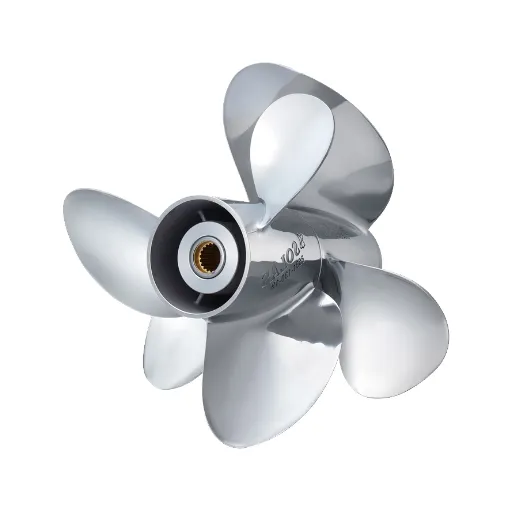
Sharrow Propeller Design
The Sharrow Propeller Design is one of the recent marvels of efficient advancement in the realm of marine propulsion. The design is based on a looped blade structure quite distinct from the flat-blade form employed in traditional propellers. By avoiding the presence of blade tip vortices whence power losses and drag occur on conventional propellers, the uninterrupted loop of the blade is vital. Less turbulence and less energy dissipation mean more energy can be transferred by the Sharrow Propeller, with the other advantages of spare fuel and smooth running. This makes it a solution particularly in demand by commercial fleets and recreational platforms who want to optimize performance and reduce environmental impacts.
Noise and vibration minimization moving to the foreground in the working of Sharrow Propeller Design. Due to uninterrupted blades, this would enable a steady interaction with the water flow, altering pressure fluctuations that would inhibit noise creation. This is very much favorable in high-performance operation or, for that matter, in eco-sensitive marine environments where noise pollution can hinder an ecosystem or impair passenger experience. Reduced stress on the propelling system leads to lesser maintenance and, hence, greater operational reliability.
Key Benefits of Sharrow Propeller Technology
Industry testing and analysis indicate that vessels fitted with Sharrow Propellers may realize an energy saving of as much as 9 to 15% compared with their conventional counterparts. This yield into a sharp plunge in fuel expense and greenhouse gas emission, thus placing maritime operations side by side with global sustainability goals. By sharpening the hydrodynamics along with precision engineering, the Sharrow Propeller takes the crown for marine efficiency and environmental stewardship. Under continued research and development activities, this technology, however, can further streamline marine propulsion systems, offering an opportunity for wider commercialization in both commercial and recreational sectors.
Compatibility with Electric Propulsion
This propeller is to the utmost degree suitable for electric propulsion systems, whose existence is rapidly increasing in present-day marine technology. Through its special blade design and low-drag nature, it serves to enhance the overall working efficiency of the electric motors by losing much less energy during operations. Such synergy is, indeed, vital, as electric propulsion systems are to a great extent dependent on power maximization efficiency to preserve battery potential and gain distance range. Furthermore, the Sharrow Propeller reduces cavitation and vibration formation, aiding in making the vessel extremely quiet and even smoother. Therein lies the fundamental factor concerning environmentally friendly and low-noise electric vessels.
The electric propulsion lost much of the hype in the most recent years since it offers almost a complete eradication of emissions and fuel consumption in all measures. There is a rise in commercial applications in ferries, fishing boats, and leisure crafts. The Sharrow Propeller acts in synergy, since the design improves performance at lower RPMs, which is usually a trait of electric motors, and together they enhance the operational efficiency of the system and also help to achieve the sustainability goals of the marine industry in mitigating the environmental impact by providing an assurance of operational capability and speed.
With time, battery technologies develop and the capacity for high-power electric motors increases, thereby making the efficiency that Sharrow Propeller affords very much relevant. Being designed with aerodynamics in mind, it gives a good thrust and performance to help the electric marine system realize its full potential.
Anti-Fouling Coatings and Foldable Designs
Anti-fouling coatings play vital roles in maintaining and retaining the efficiency and longevity of marine vessels. Such coatings prevent accumulation of marine organisms like algae and barnacles on the hull, which increases drag, hence reducing speed. Being able to resist biofouling makes the coatings help in improving fuel efficiency and lowering maintenance costs; thus, offering a truly sustainable solution to the marine industry. Modern anti-fouling technologies, on the plus side, enter into the environment-friendly route by incorporating many non-toxic substances to reduce environmental hazards.
In different marine fields, innovative technology is used for folding mechanisms that are meant to enhance performance and functionality. These designs can be folded up, stored, or transformed, enabling propellers or solar panels to save time and give operational freedom. Foldable designs are highly favorable for small boats or in instances where flexibility is crucial for sailboats and recreational craft. Hence, this new design approach will affect performance and open avenues for marine engineering.
I believe in the league of anti-fouling coatings, foldable designs will play their part in improving sustainability and performance for the marine sector. This kind of technology is a perfect example of how technology may intercede to work around an environmental issue on the one hand and to work toward operational excellence thereafter. Through solutions like these, we can lessen the impact marine operations have on the environment, and yet, speed, efficiency, and new ideas will continue to evolve.
Conclusion and Key Takeaways
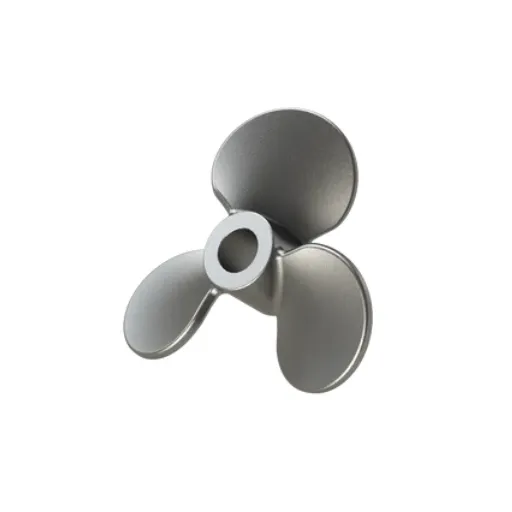
Summary of Key Differences
While analyzing anti-fouling coatings against foldable designs, the key differences exist in their primary objectives and secondary-operational impacts. Anti-fouling coatings consider preserving vessel performance by preventing biofouling, which in turn enhances fuel efficiency and carbon emissions. These coatings thus address environmental concerns for the marine industry by limiting the ecological disturbances caused by invasive species and excessive fuel consumptions.
Foldable designs, on the other hand, emphasize space optimization and versatility. With these ingenious solutions, vessels can be adapted to conform with variable cargo demands, thus allowing improved storage efficiency and quicker idle reductions. Whereas they may lack a direct environmental outlook which anti-fouling coatings do possess, their presence in promoting operational flexibility and cost-effectiveness cannot be ignored.
While the concepts generally address different issues on shipping operations, they in a way generally illustrate the industry’s view towards a balance between sustainability, efficiency, and innovations. In any case, reports say, among others, advanced anti-fouling technology can bring about an improvement in fuel savings by 10%, while space optimization through foldable designs can result in a 20% increase in efficiency. Therefore, seen as complementary solutions, a blank check approach might be needed to tackle today’s maritime challenges.
Final Thoughts on Propeller Selection
Propeller selection remains paramount in optimizing any vessel for its gross operational efficiency, environmental issues, and dividends. With modern developments in CFD, propeller designs can be modeled with precision, allowing an engineer to assess a design over a spectrum of all conditions. Data-driven insights promote the idea that a good shape design of the blade can reduce fuel consumption to the tune of 15%, which is very relevant in a fuel-based business. Materials innovations are increasingly receiving attention, such as composite propellers, with the argument of being lighter, more durable, and requiring less maintenance.
That efficient propeller designs should be teamed up with new technologies-for instance, energy recovery systems or hybrid propulsion-for performance that is agnostic to the future. For example, an installation of contra-rotating propeller systems can unexpectedly gain 6%-10% more efficiency in propulsion because of the reduction in losses of rotational energy. Predictive maintenance, based on AI and IoT systems, further secures insights for sustaining the performance and lifespan.
It must be realized that the right propeller will be chosen by taking a holistic view depending on vessel type, operating profile, and regulatory compliance as regulated. The next big improvements in the area will, therefore, impart the urgency of working with innovation at the forefront across engineers, manufacturers, and fleet operators.
Evaluating Your Propeller Needs
Choosing the right propeller for a vessel calls for an exhaustive analysis of the technical considerations, operational objectives, and governing guidelines. The procedure is commenced by focusing on the nature of the operations the vessel engages in, the hull design, and the operating conditions. Total weight, engine power, cruising speed, and fuel consumption are key in choosing a propeller. Engineers evaluate the performance of the propeller in variable sea conditions to satisfy the particular requirements presented by the different route and operating profile of the vessel. Having a wrong propeller either wastes energy, consumes more fuel, or even gives a faster wear to propulsion systems.
Today’s computational and hydrodynamic testing-modeling methods reveal pivotal aspects of analyzing various propeller designs. Professionals employ an array of simulation tools, including Computational Fluid Dynamics (CFD), to understand water flow around the blade surfaces and study ways to improve thrust and cavitation behavior. Material innovation also expanded the options for selection of propellers, including new highly durable alloys and composites that combine lighter weight with high corrosion and mechanical wear resistance. All these tools and technologies provide for a data-driven exactness in preparing propeller designs for optimal performance under variable operating conditions.
Also considered during this evaluation are the various emissions and efficiency regulations that stand in the international spectrum of regulations, such as the one put forth by the International Maritime Organization (IMO). Energy-optimized propulsion systems must conform to such standards as the Energy Efficiency Design Index (EEDI) and the decarbonization guidelines, while the propeller evaluation and selection usually require naval architects to work close with the engine manufacturers to balance propeller characteristics with engine performance and least environmental impact. And thus, the future of propeller evaluation rests in combining traditional marine engineering know-how with modern technology, to work towards vessel performance goals and operational sustainability in the long term.
References
-
Marine Propellers – A detailed academic handout from MIT discussing propeller handedness and its effects.
-
Underwater Vehicle Maneuvering with a Single Bladed Propeller – A thesis from the University of Rhode Island exploring propeller dynamics.
-
Lateral Propeller Forces and Their Effects on Shaft Bearings – A paper from the International Conference on Marine Propulsors analyzing propeller forces.
Frequently Asked Questions (FAQ)
Q: How does the direction of rotation influence thrust efficiency?
The thrust efficiency depends on the diameter and pitch of the propeller and more importantly on the rotation direction of the propeller. A right-hand propeller would produce maximum thrust in the direction of right-rotation, whereas the left-hand one is in the opposite of this. So far, right and left rotation are used to counteract each other’s torque effect and contribute to vessel performance.
Q: What are the uses of left-handedly and right-handedly rotating propellers?
Both kinds of propellers are typical in marine applications: inside boats and jet ski impellers. These propellers are used in the twin-engine setup where each propeller rotates in opposite directions to counteract yaw and thus improve stability.
Q: Can two propellers work together but rotate in different directions?
With two propellers operating in opposite directions, a standard setup is often considered for multi-propeller configurations in which a left-hand and right-hand propeller work together to enhance stability and steering and counteract transverse thrust.
Q: How does the number of blades affect the propeller’s performance?
More or fewer blades on a propeller will influence the thrust, hence its efficiency and fuel economy. A right-hand or left-hand propeller with more number of blades can provide maximum forward thrust in one revolution, useful for some marine applications.
Q: How does the right-hand propeller impact steering?
A right-hand propeller creates a side thrust, affecting the steering. When the right-hand propeller rotates, it thrusts water towards the right; hence the boat will turn to the left. This reaction is essential for steering and stability under different conditions.
Q: What are special propellers and how do they differ from standard left- or right-handed propellers?
The special propellers are designed for particular application performances. Unlike the standard left- or right-handed propellers, these special designs can differ with respect to blade shapes or pitch to increase thrust and efficiency in special marine operational conditions.
Q: How do left-hand propellers counteract torque effects?
Torque effects are countered by left-hand propellers by exerting a rotational force around the propeller shaft that acts against the engine torque. This is crucial for high-speed applications in marine where torque counter-effect and stability are important for safety and performance.





